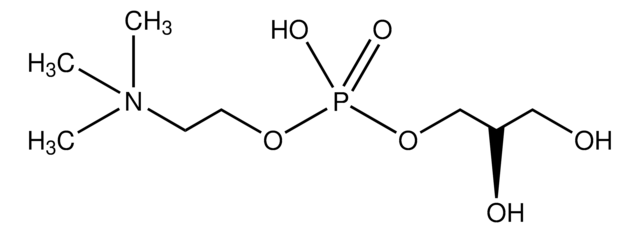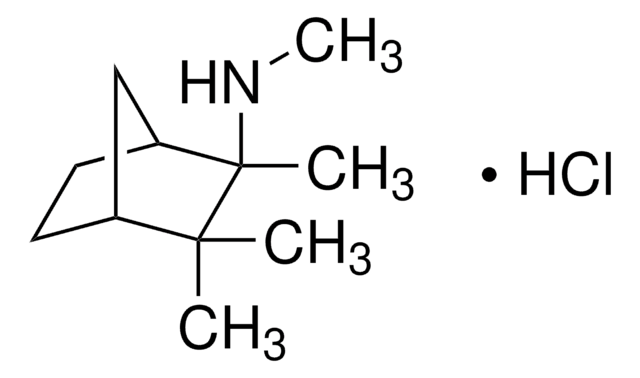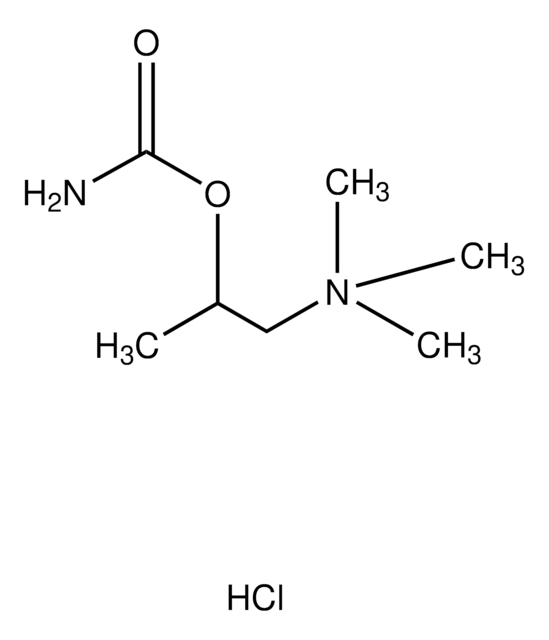推荐产品
化驗
≥98% (HPLC)
形狀
solid
儲存條件
protect from light
顏色
white
溶解度
H2O: ≥2 mg/mL
DMSO: >20 mg/mL
儲存溫度
2-8°C
SMILES 字串
[I-].[I-].C[N+](C)(C)CC[N+]1(C)Cc2c(Cl)c(Cl)c(Cl)c(Cl)c2C1
InChI
1S/C14H20Cl4N2.2HI/c1-19(2,3)5-6-20(4)7-9-10(8-20)12(16)14(18)13(17)11(9)15;;/h5-8H2,1-4H3;2*1H/q+2;;/p-2
InChI 密鑰
FPNVAOZHQUJJJQ-UHFFFAOYSA-L
應用
Chlorisondamine diiodide has been used:
- as a nicotinic receptor antagonist to test its effect on trinitrobenzene sulfonic acid (TNBS)-induced colitis
- as an irreversible nicotinic acetylcholine(nAChR) blocker to pre-treat brain samples to test its effect on cytochrome P450 2B (CYP2B) induction
- as a ganglionic blocker to test its effect on regulating corticosterone levels in rat with chronic stress
生化/生理作用
Chlorisondamine diiodide mediates ganglionic and central blockade.
Irreversible, long-lasting nicotinic acetylcholine receptor antagonist.
特點和優勢
This compound is a featured product for Neuroscience research. Click here to discover more featured Neuroscience products. Learn more about bioactive small molecules for other areas of research at sigma.com/discover-bsm.
This compound is featured on the Acetylcholine Receptors (Nicotinic) page of the Handbook of Receptor Classification and Signal Transduction. To browse other handbook pages, click here.
訊號詞
Warning
危險聲明
危險分類
Acute Tox. 4 Oral - Aquatic Acute 1
儲存類別代碼
11 - Combustible Solids
水污染物質分類(WGK)
WGK 2
閃點(°F)
Not applicable
閃點(°C)
Not applicable
個人防護裝備
dust mask type N95 (US), Eyeshields, Gloves
G Costa et al.
Brain research, 888(2), 336-342 (2001-01-11)
While the work of several groups has shown the neuroprotective effects of nicotine in vitro, evidences for the same effects in vivo are controversial, mainly regarding neuroprotection in experimental models of Parkinson's disease. In this context, we investigated the capability
T Marenco et al.
British journal of pharmacology, 129(1), 147-155 (2000-02-29)
Chlorisondamine blocks central nicotinic receptors for many weeks via an unknown mechanism. Intracerebroventricular administration of [(3)H]-chlorisondamine in rats results in an anatomically restricted and persistent intracellular accumulation of radioactivity. The initial aim of the present study was to test whether
T Mori et al.
Molecular pharmacology, 59(4), 732-743 (2001-03-22)
Inhalational general anesthetics have recently been shown to inhibit neuronal nicotinic acetylcholine (ACh) receptors (nnAChRs) expressed in Xenopus laevis oocytes and in molluscan neurons. However, drug actions on these systems are not necessarily the same as those seen on native
A Bai et al.
Scandinavian journal of immunology, 66(5), 538-545 (2007-10-24)
Inflammatory bowel diseases (IBD) are characterized by proinflammatory cytokines, tissue damage and loss of neuron in inflamed mucosa, which implies the cholinergic anti-inflammatory pathway may be destroyed during the process of inflammatory response. In the study, we identified the effect
Colin S Cunningham et al.
Pharmacology, biochemistry, and behavior, 179, 27-33 (2019-02-10)
Mecamylamine is a non-competitive nicotinic acetylcholine receptor (nAChR) antagonist that has been prescribed for hypertension and as an off-label smoking cessation aid. Here, we examined pharmacological mechanisms underlying the interoceptive effects (i.e., discriminative stimulus effects) of mecamylamine (5.6 mg/kg s.c.)
我们的科学家团队拥有各种研究领域经验,包括生命科学、材料科学、化学合成、色谱、分析及许多其他领域.
联系技术服务部门








